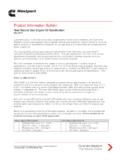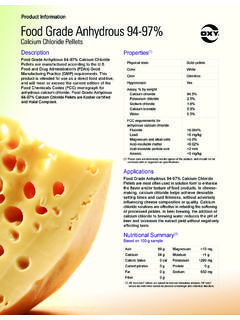Transcription of HIGHLIGHTS OF PRESCRIBING INFORMATION …
1 HIGHLIGHTS OF PRESCRIBING INFORMATION . _____. These HIGHLIGHTS do not include all the INFORMATION needed WARNINGS AND PRECAUTIONS_____. to use latisse safely and effectively. See full Concurrent administration of latisse and PRESCRIBING INFORMATION for latisse . intraocular pressure (IOP)-lowering prostaglandin analogs in ocular hypertensive patients may latisse (bimatoprost ophthalmic solution) decrease the IOP-lowering effect. Patients using Initial Approval: 2001 these products concomitantly should be closely monitored for changes to their IOP. ( ). _____. INDICATIONS AND USAGE_____.. latisse is a prostaglandin analog, indicated to treat Pigmentation of the eyelids and iris may occur. hypotrichosis of the eyelashes by increasing their growth Iris pigmentation is likely to be permanent.
2 ( , including length, thickness and darkness. (1) ). _____. DOSAGE AND ADMINISTRATION_____ _____. ADVERSE REACTIONS_____. Apply nightly directly to the skin of the upper eyelid margin Most common adverse reactions (incidence at the base of the eyelashes using the accompanying approximately 3% - 4%) are eye pruritus, conjunctival applicators. Blot any excess solution beyond the eyelid hyperemia, and skin hyperpigmentation. ( ). margin. Dispose of the applicator after one use. Repeat for the opposite eyelid margin using a new sterile applicator. (2) To report SUSPECTED ADVERSE REACTIONS, contact Allergan at 1-800-678-1605 or the FDA at _____. DOSAGE FORMS AND STRENGTHS_____ 1-800-FDA-1088 or Bimatoprost ophthalmic solution mg/mL.
3 (3). See 17 for PATIENT COUNSELING. _____. CONTRAINDICATIONS _____ INFORMATION and FDA-approved patient Hypersensitivity. (4) labeling (Patient INFORMATION ). Revised: 07/2017. FULL PRESCRIBING INFORMATION : CONTENTS*. 1 INDICATIONS AND USAGE 12 CLINICAL PHARMACOLOGY. 2 DOSAGE AND ADMINISTRATION Mechanism of Action 3 DOSAGE FORMS AND STRENGTHS Pharmacokinetics 4 CONTRAINDICATIONS 13 NONCLINICAL TOXICOLOGY. 5 WARNINGS AND PRECAUTIONS Carcinogenesis, Mutagenesis, Effects on Intraocular Pressure Impairment of Fertility Iris Pigmentation 14 CLINICAL STUDIES. Lid Pigmentation 16 HOW SUPPLIED/STORAGE AND HANDLING. Hair Growth Outside the Treatment Area 17 PATIENT COUNSELING. Intraocular Inflammation INFORMATION . Macular Edema Contamination of latisse or Applicators Use with Contact Lenses * Sections or subsections omitted from the full PRESCRIBING 6 ADVERSE REACTIONS INFORMATION are not listed.
4 Clinical Trial Experience Postmarketing Experience 8 USE IN SPECIFIC POPULATIONS. Pregnancy Lactation Pediatric Use Geriatric Use 11 DESCRIPTION. FULL PRESCRIBING INFORMATION . 1 INDICATIONS AND USAGE. latisse (bimatoprost ophthalmic solution) is indicated to treat hypotrichosis of the eyelashes by increasing their growth including length, thickness and darkness. 2 DOSAGE AND ADMINISTRATION. Ensure the face is clean, makeup and contact lenses are removed. Once nightly, place one drop of latisse . (bimatoprost ophthalmic solution) on the disposable sterile applicator supplied with the package and apply evenly along the skin of the upper eyelid margin at the base of the eyelashes. The upper lid margin in the area of lash growth should feel lightly moist without runoff.
5 Blot any excess solution runoff outside the upper eyelid margin with a tissue or other absorbent cloth. Dispose of the applicator after one use. Repeat for the opposite eyelid margin using a new sterile applicator. Do not reuse applicators and do not use any other brush/applicator to apply latisse . Do not apply to the lower eyelash line [see Warnings and Precautions ( , ) and Patient Counseling INFORMATION (17)]. Additional applications of latisse will not increase the growth of eyelashes. Upon discontinuation of treatment, eyelash growth is expected to return to its pre-treatment level. 3 DOSAGE FORMS AND STRENGTHS. Bimatoprost ophthalmic solution mg/mL. 4 CONTRAINDICATIONS. latisse is contraindicated in patients with hypersensitivity to bimatoprost or to any of the ingredients [see Adverse Reactions ( )].
6 5 WARNINGS AND PRECAUTIONS. Effects on Intraocular Pressure Bimatoprost ophthalmic solution (LUMIGAN ) lowers intraocular pressure (IOP) when instilled directly to the eye in patients with elevated IOP. In clinical trials, in patients with or without elevated IOP, latisse . lowered IOP, however, the magnitude of the reduction was not cause for clinical concern. In ocular hypertension studies with LUMIGAN , it has been shown that exposure of the eye to more than one dose of bimatoprost daily may decrease the intraocular pressure lowering effect. In patients using LUMIGAN . or other prostaglandin analogs for the treatment of elevated intraocular pressure, the concomitant use of latisse may interfere with the desired reduction in IOP.
7 Patients using prostaglandin analogs including LUMIGAN for IOP reduction should only use latisse after consulting with their physician and should be monitored for changes to their intraocular pressure [see Patient Counseling INFORMATION (17)]. Iris Pigmentation Increased iris pigmentation has occurred when bimatoprost solution was administered. Patients should be advised about the potential for increased brown iris pigmentation which is likely to be permanent [see Adverse Reactions ( ) and Patient Counseling INFORMATION (17)]. The pigmentation change is due to increased melanin content in the melanocytes rather than to an increase in the number of melanocytes. The long term effects of increased pigmentation are not known.
8 Iris color changes seen with administration of bimatoprost ophthalmic solution may not be noticeable for several months to years. Typically, the brown pigmentation around the pupil spreads concentrically towards the periphery of the iris and the entire iris or parts of the iris become more brownish. Neither nevi nor freckles of the iris appear to be affected by treatment. Treatment with latisse solution can be continued in patients who develop noticeably increased iris pigmentation. Lid Pigmentation Bimatoprost has been reported to cause pigment changes (darkening) to periorbital pigmented tissues and eyelashes. The pigmentation is expected to increase as long as bimatoprost is administered, but has been reported to be reversible upon discontinuation of bimatoprost in most patients [see Patient Counseling INFORMATION (17)].
9 Hair Growth Outside the Treatment Area There is the potential for hair growth to occur in areas where latisse solution comes in repeated contact with the skin surface. It is important to apply latisse only to the skin of the upper eyelid margin at the base of the eyelashes using the accompanying sterile applicators, and to carefully blot any excess latisse from the eyelid margin to avoid it running onto the cheek or other skin areas [see Patient Counseling INFORMATION (17)]. Intraocular Inflammation latisse solution should be used with caution in patients with active intraocular inflammation ( , uveitis). because the inflammation may be exacerbated. Macular Edema Macular edema, including cystoid macular edema, has been reported during treatment with bimatoprost ophthalmic solution (LUMIGAN ) for elevated IOP.
10 latisse should be used with caution in aphakic patients, in pseudophakic patients with a torn posterior lens capsule, or in patients with known risk factors for macular edema. Contamination of latisse or Applicators The latisse bottle must be kept intact during use. It is important to use latisse solution as instructed, by placing one drop on the single-use-per-eye applicator. The bottle tip should not be allowed to contact any other surface since it could become contaminated. The accompanying sterile applicators should only be used on one eye and then discarded since reuse of applicators increases the potential for contamination and infections. There have been reports of bacterial keratitis associated with the use of multiple-dose containers of topical ophthalmic products [see Patient Counseling INFORMATION (17)].








